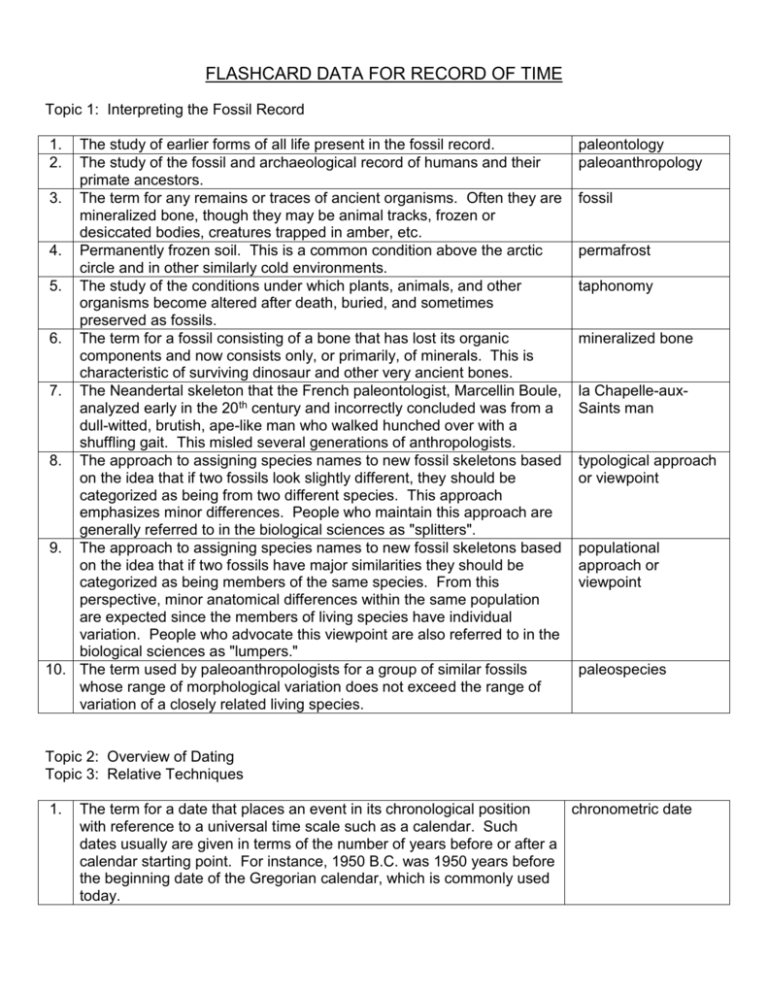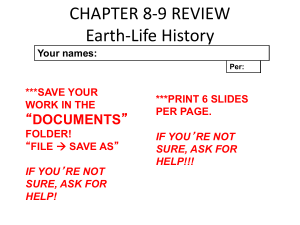
FLASHCARD DATA FOR RECORD OF TIME
Topic 1: Interpreting the Fossil Record
1.
2.
The study of earlier forms of all life present in the fossil record.
The study of the fossil and archaeological record of humans and their
primate ancestors.
3. The term for any remains or traces of ancient organisms. Often they are
mineralized bone, though they may be animal tracks, frozen or
desiccated bodies, creatures trapped in amber, etc.
4. Permanently frozen soil. This is a common condition above the arctic
circle and in other similarly cold environments.
5. The study of the conditions under which plants, animals, and other
organisms become altered after death, buried, and sometimes
preserved as fossils.
6. The term for a fossil consisting of a bone that has lost its organic
components and now consists only, or primarily, of minerals. This is
characteristic of surviving dinosaur and other very ancient bones.
7. The Neandertal skeleton that the French paleontologist, Marcellin Boule,
analyzed early in the 20th century and incorrectly concluded was from a
dull-witted, brutish, ape-like man who walked hunched over with a
shuffling gait. This misled several generations of anthropologists.
8. The approach to assigning species names to new fossil skeletons based
on the idea that if two fossils look slightly different, they should be
categorized as being from two different species. This approach
emphasizes minor differences. People who maintain this approach are
generally referred to in the biological sciences as "splitters".
9. The approach to assigning species names to new fossil skeletons based
on the idea that if two fossils have major similarities they should be
categorized as being members of the same species. From this
perspective, minor anatomical differences within the same population
are expected since the members of living species have individual
variation. People who advocate this viewpoint are also referred to in the
biological sciences as "lumpers."
10. The term used by paleoanthropologists for a group of similar fossils
whose range of morphological variation does not exceed the range of
variation of a closely related living species.
paleontology
paleoanthropology
fossil
permafrost
taphonomy
mineralized bone
la Chapelle-auxSaints man
typological approach
or viewpoint
populational
approach or
viewpoint
paleospecies
Topic 2: Overview of Dating
Topic 3: Relative Techniques
1.
The term for a date that places an event in its chronological position
chronometric date
with reference to a universal time scale such as a calendar. Such
dates usually are given in terms of the number of years before or after a
calendar starting point. For instance, 1950 B.C. was 1950 years before
the beginning date of the Gregorian calendar, which is commonly used
today.
2.
The term for a date that gives the time of an event only with reference
to another event that is not worldwide in scale. It only indicates that
one event occurred earlier or later than another. For instance, the
observation that strata 2 is younger than strata 1 beneath it in a
geological deposit does not provide information about how many years
ago strata 2 was laid down. It only indicates its age relative to strata 1.
3. A kind of chronometric date that is measured in years before the
present. By convention, scientists have assigned 1950 A.D. in the
Gregorian calendar as the present.
4. The idea that if there are layers in a sedimentary deposit, those laid
down first will be on the bottom and those laid down last will be on the
top. This principle is the basis for one of the commonly used relative
dating techniques.
5. The study of geological strata, or layers of rock or soil, usually for
relative dating based on the principle of superposition.
6. The term for breaks in the original stratigraphic sequence of a
geological deposit. Understanding all of these changes in an area is a
prerequisite for using stratigraphy for relative dating purposes.
7. The idea that if two objects are found undisturbed in the same strata of
a site, they very likely date to the same time period. This principle can
be used for relative dating purposes.
8. A term referring to the position in a site where an object was originally
deposited. Finding an artifact or fossil undisturbed in this way allows a
researcher to apply the principle of association in dating and
interpreting it. This can not be done if the object is in a secondary
context, which is to say that it was moved to a new location after the
original deposition.
9. The remains of a plant or animal of a species that is known to have
lived only during a specific time period. The discovery of such a fossil
in an archaeological site is circumstantial evidence of the approximate
time period that it was occupied. These fossils can be used to relatively
date the remains of our ancient ancestors if they were found in
association with each them.
10. The name for the relative dating technique that is based on the
discovery of index fossils.
11. A relative dating method based on the fact that bones buried in the
ground progressively lose nitrogen and gain fluorine and other trace
elements. If two bones from the same site have markedly different
amounts of nitrogen and fluorine, it is a strong indication that they did
not come from the same time period. The bone with the least amount
of nitrogen and the greatest amount of fluorine is most likely the oldest.
12. The name of a presumably very ancient human skull and jaw found in
England in 1912 by Charles Dawson. As a result of fluorine analysis
testing in the early 1950’s, this fossil was found to be an elaborate
hoax.
relative date
B.P. date
principle of
superposition
stratigraphy
unconformity or
geological
unconformity
principle of
association
primary context
index fossil
biostratigraphy
fluorine analysis
dating
Piltdown Man hoax
Topic 4: Chronometric Techniques
1.
The study of annual growth-rings of trees, usually for the purpose of
chronometric dating logs and, subsequently, human remains and
artifacts found in association with them.
2. A chronometric dating method based on the fact that the magnetic
north and south poles periodically reverse. A permanent record of
these reversals can be found in the thermoremnant magnetism of
volcanic rock deposits. When fossils are found sandwiched between
such volcanic layers, they can be dated by association--i.e., a minimum
and a maximum age can be assigned.
3. A chronometric dating method based on the fact that amino acids
progressively change to mirror image forms following the death of an
organism--i.e., from L-amino acid to D-amino acid forms.
4. Magnetic fields that are altered or formed in atoms of iron by heat in
excess of 1100°F. (600° C.). Such fields line up with the magnetic field
of the Earth at the time of the exposure to a high temperature. They
will remain oriented to that direction indefinitely despite the fact that the
true position of magnetic north wanders over thousands of miles around
the rotational north pole and even reverses with the magnetic south
pole over longer periods of time.
5. The point on the northern extremity of the earth where the axis of
rotation is located. Compared to the magnetic north pole, this one is
relatively stable.
6. A term referring to techniques for chronometric dating based on known
half-lives of particular isotopes or the rate of other cumulative changes
in atoms resulting from radioactivity. Examples include electron spin
resonance, fission track, potassium-argon, radiocarbon, and
thermoluminescence dating.
7. A radiometric dating method based on the fact that potassium-40 in
volcanic rock decays into argon-40 and calcium-40 at a known rate.
Chronometric dates are determined by measuring the amount of argon40 in a sample.
8. A radiometric dating method based on the fact that the amount of
carbon-14 steadily decreases in all organisms after death. This
technique is used to provide chronometric dates for organic materials
such as bone, shell, wood, and charcoal.
9. The process by which plants, algae, and some bacteria use energy
from sun light to create new organic molecules out of carbon dioxide
and water.
10. The amount of time for half of the atoms of a radioactive element in a
sample to decay, or fission. The reduction in the number of atoms
follows a geometric scale.
dendrochronology or
tree-ring dating
Paleomagnetic dating
(or geomagnetic
reversal time scale
dating or geomagnetic
polarity time scale
dating)
amino acid
racemization dating
thermoremnant
magnetism
rotational north pole
radiometric dating
potassium-argon
dating (K-Ar dating)
radiocarbon dating
(carbon-14 dating)
photosynthesis
half-life
11. A dating technique using a research instrument primarily employed in
physics to accelerate streams of charged subnuclear particles to high
velocities in order to sort and analyze them. This technique is now also
used to count individual carbon isotope atoms for radiocarbon dating.
The advantage of this technique over the conventional radiocarbon
method is that it requires a far smaller sample size and can potentially
provide dates going back to around 100,000 B.P.
12. A radiometric dating method based on the fact that when trace amounts
of uranium-238 decay, there is a release of highly energy-charged
alpha particles which burn narrow tracks, or damage trails, through
glassy materials like obsidian (i.e., volcanic glass).
13. A radiometric dating method based on the fact that background
radiation causes electrons to separate from their atoms and become
trapped in the crystal lattice of minerals. When heated to high
temperatures, the trapped electrons are released and they give off
energy in the form of light. The characteristic of that light is measured
to determine the age of the sample. This technique is mainly used to
date pottery and rock that previously had been in an intense fire.
14. A radiometric dating method based on the fact that background
radiation causes electrons to separate from their atoms and become
trapped in the crystal lattice of minerals. This progressively alters the
magnetic field of the material at a predictable rate. The magnetic field
of the atoms in a sample is measured to determine the age. This
technique is employed primarily to chronometrically date calcium
carbonate in limestone, coral, teeth, and egg shells.
15. Any of two or more forms of an element that differ in terms of atomic
mass but have the same atomic number--for example, carbon-12 and
carbon-14.
Copyright © 2005-2012 by Dennis O'Neil. All rights reserved.
accelerator mass
spectrometer dating
(AMS dating)
fission track dating
thermoluminescence
dating (TL dating)
electron spin
resonance dating
(ESR dating)
isotope







